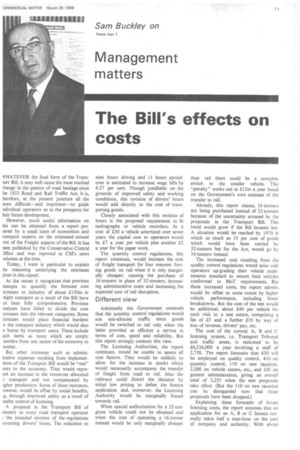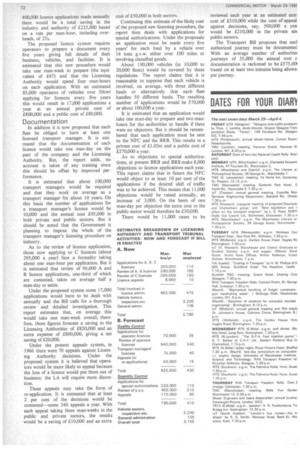The Bill's effects on costs
Page 73

Page 74

If you've noticed an error in this article please click here to report it so we can fix it.
WHATEVER the final form of the Transport Bill, it may well cause the most marked :hange in the pattern of road haulage since he 1933 Road and Rail Traffic Act. It is, herefore, at the present juncture all the nore difficult—and important—to guide ndividual operators as to the prospects for heir future development.
However, much useful information on his can be obtained from a report prePared by a small team of economists and rampart experts on the estimated annual ost of the Freight aspects of the Bill. It has Peen published by the Conservative Central )ffice and was reported in CM's news
IUMIIS at the time.
Today, I want in particular to explain he reasoning underlying the estimates ;iven in this report.
At the outset it recognizes that previous ttempts to quantify the forecast cost icreases to industry of about £150m in -eight transport as a result of the Bill have ot been fully comprehensive. Previous nalyses have failed to divide the cost icreases into the relevant categories. Some icreases would place financial burdens n the transport industry which would also e borne by transport users. These include uch items as taxes which are simply :ansfers from one sector of the economy to nother.
But other increases such as adtninitrative expenses resulting from implemenItion of the Transport Bill would be "real" osts to the economy. They would repreent an increase in the resources allocated ) transport and not compensated by igher production. Some of these increases, owever, would be offset by social benefits, .g. through improved safety as a result of uality control of licensing.
A proposal in the Transport Bill of oncern to every road transport operator ; the intended revision of the regulations overning drivers' hours. The reduction to nine hours driving and 11 hours spreadover is estimated to increase wage bills by 6.27 per cent. Though justifiable on the grounds of improved safety and working conditions, this revision of drivers' hours would add directly to the cost of transporting goods.
Closely associated with this revision of hours is the proposed requirement to fit tachographs or vehicle recorders. At a cost of £50 a vehicle amortized over seven years the capital cost to operators would be £7 a year per vehicle plus another £2 a year for the paper work.
The quantity control regulations, this report continues, would increase the cost of freight transport for four reasons: forcing goods on rail when it is only marginally cheaper; causing the purchase of 16-tonners in place of 32-tonners; increasing administrative costs and increasing the expected cost of rail disruption.
Different view
Admittedly the Government contends that the quantity control regulations would not mis-allocate traffic since goods would be switched to rail only when the latter provided as efficient a service in terms of cost, speed and reliability. But this report strongly contests this view.
The Licensing Authorities, the report continues, would be unable to assess all cost factors. They would be unlikely to allow for the increase in stocks which would necessarily accompany the transfer of freight from road to rail. Also the railways could distort the decision by initial low pricing to defeat the licence application and, moreover, the Licensing Authority would be marginally biased towards rail.
When special authorization for a 32-tongross vehicle could not be obtained and when the cost of operating a 16-tonner instead would be only marginally cheaper than rail there could be a complete switch to the smaller vehicle. This "penalty" works out at £12m a year based on the Government's own estimate of the transfer to rail.
Already, this report claims, 16-tonners are being purchased instead of 32-tonners because of the uncertainty aroused by the proposals in the Transport Bill. This trend would grow if the Bill became law. A situation would be reached by 1970 in which as much as 15 per cent of goods which would have been carried by 32-tonners but for the Act, would go by 16-tonners instead.
The increased cost resulting from the quality control regulations would arise with operators up-grading their vehicle maintenance standard to ensure their vehicles conformed to MoT requirements. But these increased costs, the report admits, would be offset to some extent by higher vehicle performance, including fewer breakdowns. But the cost of the test would be additional, about £40 per vehicle for each visit to a test centre, comprising a fee of £5 and a further £35 by way of loss of revenue, drivers' pay, etc.
The cost of the current A, B and C licensing system, i.e. Transport Tribunal and traffic areas, is reckoned to be £6,536,000 a year involving a staff of 2,758. The report forecasts that 430 will be employed on quality control, 410 on quantity control, 110 on new taxation, 2,200 on vehicle testers, etc., and 105 on general administration, giving an overall total of 3,255 when the new proposals take effect. (But the 110 on new taxation can be disregarded now that these proposals have been dropped.) Explaining these forecasts of future licensing costs, the report assumes that an application for an A, B or C licence normally takes half a man-hour on the part of company and authority. With about 400,000 licence applications made annually there would be a total saving in the industry and authority of £225,000 based on a rate per man-hour, including overheads, of 25s.
The proposed licence system requires operators to prepare a document every five years giving full details of their business, vehicles, and facilities. It is estimated that this new procedure would take one man-week to prepare (the equivalent of £47) and that the Licensing Authority would spend four man-hours on each application. With an estimated 85,000 operators of vehicles over 30cwt applying for licences every five years this would result in 17,000 applications a year at an annual private cost of £800,000 and a public cost of £80,000.
Documentation
In addition it is now proposed that each fleet be obliged to have at least one licensed transport manager. It is estimated that the documentation of each licence would take one man-day on the part of the company and the Licensing Authority. But, the report adds, no account is taken of any training since this should be offset by improved performance.
It is estimated that about 100,000 transport managers would be required and that they work on average as a transport manager for about 10 years. On this basis the number of applications for a transport manager's licence would be 10,000 and the annual cost £95,000 in both private and public sectors. But it should be noted that the Government is planning to impose the whole of the transport manager's licensing procedure on industry.
As to the review of licence application, those now applying to C licences (about 295,000 a year) face a formality taking about one man-hour per application. But it is estimated that review of 96,000 A and B licence applications, one-third of which are contested, takes on average half a man-day to settle.
Under the proposed system some 17,000 applications would have to be dealt with annually and the Bill calls for a thorough review and detailed investigation. This report estimates that, on average this would take one man-week overall, therefore, these figures forecast a saving to the Licensing Authorities of £820,000 and an extra expense of £800,000, giving a net saving of £20,000.
Under the present appeals system, in 1966 there were 70 appeals against Licensing Authority decisions. Under the proposed system it is believed that operators would be more likely to appeal because the loss of a licence would put them out of business; the LA will require more discretion.
These appeals may take the form of re-application. It is estimated that at least 2 per cent of the decisions would be contested-some 340 appeals a year. With each appeal taking three man-weeks in the public and private sectors, the results would be a saving of £10,000 and an extra cost of £50,000 in both sectors.
Continuing this estimate of the likely cost of the proposed new licensing procedure, the report then deals with applications for special authorizations. Under the proposals an application must be made every five years' for each haul by a vehicle over 16 tons g.v.w. either over 100 miles or involving classified goods.
About 190,000 vehicles (in 10,000 to 20,000 fleets) would be covered by these regulations. The report claims that it is reasonable to suppose that each vehicle is involved, on average, with three different hauls or alternatively that each fleet handles 50 different hauls. The resulting number of applications would be 570,000 or about 100,000 a year.
It is estimated that an application would take one man-day to prepare and two manhours for the authorities to handle if there were no objectors. But it should be remembered that each application must be sent to the NFC and the BRB. This results in a private cost of £1.03m and a public cost of £270,000 a year.
As to objections to special authorizations, at present BRB and BRS make 8,000 objections to licence applications each year. This report claims that in future the NFC would object to at least 10 per cent of the applications if the desired shift of traffic was to be achieved. This means that 11,000 objections would be raised annually, an increase of 3,000. On the basis of one man-day per objection the extra cost to the public sector would therefore be £30,000.
There would be 11,000 cases to be reviewed each year at an estimated extr cost of £510,000 while the cost of appeal against decisions, say, 500,000 a yea would be £210,000 in the private an public sectors.
The Transport Bill proposes that eacl authorized journey must be documented With an average number of authorize( journeys of 55,000 the annual cost o documentation is reckoned to be £575,001 based on at least two minutes being allowe, per journey.
























































































































